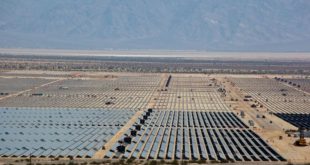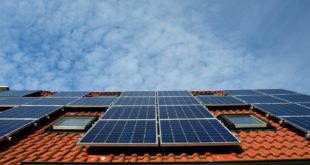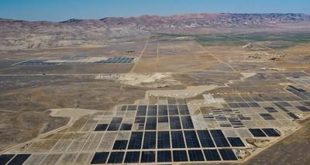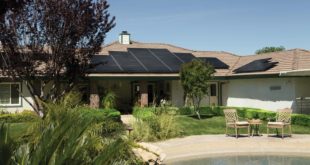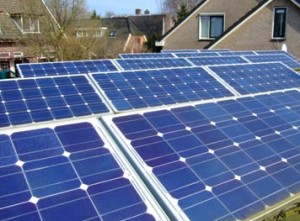 The solar power industry sustained an impressive growth in installed capacity with new capacity of 27.7 Gigawatts (GW) coming on line in 2011, on top of over 17 GW in 2010. This takes the total installed capacity worldwide to 67.44 GW. The capital cost of solar photovoltaic power plants have declined to around $2430 / kilowatt, which makes it possible to produce solar power at around $0.10 per kilowatt-hour, a tariff close to the grid parity level that is needed for solar power to take off.
The solar power industry sustained an impressive growth in installed capacity with new capacity of 27.7 Gigawatts (GW) coming on line in 2011, on top of over 17 GW in 2010. This takes the total installed capacity worldwide to 67.44 GW. The capital cost of solar photovoltaic power plants have declined to around $2430 / kilowatt, which makes it possible to produce solar power at around $0.10 per kilowatt-hour, a tariff close to the grid parity level that is needed for solar power to take off.
This decline in capital and power generation costs are coupled with governmental action world-wide with preferential buying solar power at attractive feed in tariffs, trade-able carbon credits and accelerated depreciation of assets. This has made it attractive for power developers to invest in solar power even in these times of turbulence in the global financial markets. The top 5 countries ranked by the total installed capacity are as below.
1. Germany
Germany leads the world with an installed solar power capacity of 17.193 GW at the end of 2010 to which 9.785 GW of new capacity was added in 2011, for a total of 26.978 GW which is close to 40 per cent of the total global installed capacity.
Germany has already announced a plan to go 100 percent renewable energy by 2050. While a large part of that plan is to use hydroelectric power from the Nordic countries through the interconnected European smart grid under construction, solar power cold contribute about 25 percent of the total power needs by that year. Germany offers attractive feed-in-tariff for solar power and lowest system prices and long term contracts that attract investors. German utility companies are also offering to sign long term purchase contracts for solar power produced in other European countries like Spain, Italy and Portugal which has made it possible for projects in those cash strapped countries to secure financing. Though some of the incentives for new solar power plants are to be reduced from April 2012, the German government is confident that between 2 and 3 GW of new capacity will be added each year.
The largest single solar power project in Germany is at Finsterwalde with an installed capacity of 80.7 MW. This underlines the fact that the capacity addition is in the form of multiple new plants rather than a few mega-plants. The solar power industry is also reported to have created over a 100,000 new jobs in the past few years, another factor that would assure continued government support to this industry.
2. Spain
Spain is number two with an installed capacity of 3.784 GW at end of 2010 to which was added only 69 MW in 2011, taking the total installed capacity to 3.853 GW at end of 2011. At this level, solar power already contributes around 12 percent of the country’s power production.
Spain’s financial difficulties have led to major cutbacks in subsidies to solar power projects and a cap of 500 MW of capacity addition for the next few years. The world’s largest commercial scale concentrated solar power plant at Andasol with 150 MW capacities has put on hold further phases of its expansion until the picture on incentives becomes clearer. The Andasol promoters are now examining locations in Morocco and North Africa for replication of the successful modular plants built at Andasol.
3. Japan
For a country that is short on land space, Japan has 3.662 GW of solar power capacity, having added over 1.1 GW in 2011, making it the third largest in our listing of the top 5 solar power producing countries. The Fukushima nuclear plant shutdown has put in doubt the future of nuclear power in Japan. Since Japan imports all of its fossil fuel needs, solar power is particularly attractive with the added advantage that Japanese manufacturers like Sharp are leaders in solar cell manufacture.
One innovative policy measure that is being discussed in Japan is the compulsory installation of photovoltaic’ on over 10 million building roofs by the year 2030. This could sustain the growth momentum for solar power in the world’s third largest economy.
4. Italy
At the end of 2009, Italy had 3.47 GW of installed capacity and that was to nearly triple by the end of 2011 to 9 GW. The growing financial problems forced the government to cut back subsidies for solar power in early 2011 after several months of uncertainty. Many on-going projects have been halted while banks renegotiate loan terms.
There are some reports that even some of the plants previously commissioned have had to halt production. There are moves by German utility consortiums to offer to purchase the power produced in the Italian plants for transmission to Germany at favorable tariffs. If these issues get resolved, we may see a major jump in installed capacity in Italy, even propelling it to second rank just behind Germany.
5. USA
The US leads the world in the advance of solar power plant technologies but that has not translated to solar power production on the scale that would seem appropriate for its size and resources. The abundant availability of fossil fuels and the state-wise environment regulations and land use laws have delayed many solar power projects.
The US installed capacity for solar power was 2.528 GW at the end of 2010 to which over 1 GW is expected to have been added in 2011. The states of California and Nevada lead with over 60 percent of solar power capacity being installed in the desert regions of these two states. Even populous New Jersey is beginning to add solar capacity due to incentives. Imaginative programs like adding solar power plants in the vast open spaces around the country’s correctional prisoner facilities and around military bases look to dramatically improve the US installed capacity in the coming years.
The issues that have slowed solar power development should get resolved in the coming years and we should expect to see phenomenal growth in solar power installation in the US in the coming years.
In addition to the top 5 countries named above, new solar power generating capacity of between 200 and 300 Megawatts was added in several other countries such as Belgium, France, and South Korea and in China and India. There was a sudden spurt of over 1 GW of solar power capacity creating even in the Czech Republic which was cut back after the government withdrew overly generous subsidies. Many countries of the Middle East and North Africa region also have announced plans to install solar power plants by inviting European and US developers to partner with local utilities. This widespread support for solar power should ensure continued fast growth of the industry.
The growth momentum in solar power generation is welcome news in the battle to contain CO2 emissions from fossil based power generation plants.
About the author: Rubela is a blogger by profession. She loves writing on technology and luxury. Beside this she is fond of gadgets. Recently an article on Gas Tankless Water Heater attracted her attention. These days she is busy in writing an article on 3D Laptop .
 Alternative Energy HQ solar power for homes, wind energy, and bio fuel issues
Alternative Energy HQ solar power for homes, wind energy, and bio fuel issues


